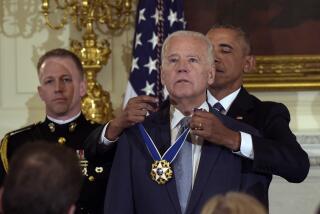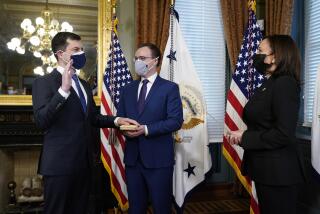Three May Be a Crowd in the White House : Campaigns: Unprecedented competition complicates key players’ relationships.
- Share via
WASHINGTON — They were competitors from Day One.
Vice President Al Gore won the West Wing office just 18 paces from the Oval Office. But First Lady Hillary Rodham Clinton got to redesign health care, with a task force of 500. Gore’s assignment? He got to reinvent government, beginning with a staff of two.
Back then, at least Al and Hillary shared a common goal: advancing a rookie president’s “new Democrat” agenda.
But 6 1/2 years later, with Gore running for president, Mrs. Clinton eyeing a Senate bid in New York and a lame-duck Bill Clinton minding his legacy, three distinct and increasingly independent-minded power centers are cohabitating in the White House.
And each side of the power triangle is staffed by loyalists doggedly representing the often competing interests of their high-octane bosses.
“It’s getting very interesting,” an aide to Mrs. Clinton said with practiced understatement.
Such tensions--now under the surface--could bubble up even more by autumn.
The three-way competition at 1600 Pennsylvania Ave. is unprecedented in American history, and it is complicating the relationships among the principals, with their every word and deed examined in microscopic detail for its possible impact on the other two.
Although the elections of 2000 are 14 months off, the first lady and the vice president already have begun staking out positions on issues that differ markedly from the president’s.
Mrs. Clinton wants greater Medicare reimbursements for New York’s teaching hospitals, which treat a disproportionate share of the poor and the elderly. Her husband wants to use his muscle to get structural Medicare reform out of Congress, not better reimbursement levels for individual hospitals.
Gore has proposed mandatory gun registration. Ever the pragmatist, Clinton is willing to settle for security checks on gun show purchases, figuring that’s the most he can get out of Congress.
For his part, Gore is juggling his role as Clinton’s loyal vice president with his political need to show independence. And sometimes they clash over emphasis. At a joint appearance in McAllen, Texas, in May, the topic was the economy. Clinton wanted to highlight those left behind in poverty. Gore wanted to highlight the administration’s progress. After several meetings and calls, Gore’s aides prevailed. But Gore’s speech was so rambling it was remembered largely as another example of his awkwardness at the podium.
For her part, Hillary Clinton is clearly enjoying a chance, after 25 years as a loyal spouse, to step out on her own. She has not flinched at distancing herself from her husband’s White House policies. Broaching the thicket of Middle East politics, she recently said she favors moving the U.S. Embassy from Tel Aviv to Jerusalem, the “eternal and indivisible capital of Israel.” And she backed federal legislation to assure dairy farmers higher prices: a winning political issue in upstate New York, but it could drive up the price of milk for consumers nationally.
As for the president, he is doing all he can to explain both his vice president and his wife--confident their success will validate his policies. But he also has some policy goals of his own. Chief among them: He wants to make the long-term stability of Medicare and Social Security the crown jewels of his legacy. Gore might prefer a legislative stalemate that ensures him use of a potent issue--Medicare reform--against his Republican opponent in 2000.
Aside from telling, if subtle, policy differences, the three are competing behind the scenes for staff talent, campaign donations and even media attention.
Such competition emerged in bold relief in mid-June, when Mrs. Clinton traveled to upstate New York to launch her “listening tour” as a prelude to a possible run for the Senate. At the same time, the president was conducting a cross-country poverty tour.
The president got plenty of ink in the local markets he visited. But it was the first lady who drew the national cameras, including live coverage of her remarks by CNN.
Hillary Clinton’s camera magnetism is taking some attention from Gore. Aides say he doesn’t begrudge her the spotlight. Others think he must resent the competition.
“After all his loyal service as vice president, Gore might have expected complete and total devotion [of the White House apparatus] to his candidacy for president,” said Larry Sabato, a University of Virginia political scientist.
Mrs. Clinton, a star fund-raiser for the Democrats, especially among women, has tried to soften the blow by appearing at Gore’s side and hailing his record among female voters, who polls show are not flocking to Gore’s candidacy.
A senior Gore advisor said that a Hillary Clinton candidacy does not “take away from the vice president’s candidacy,” adding, “except to the extent that she’s not going to be out there campaigning for him.”
As the divergence inevitably grows, it also may serve to debunk the myth that the Clintons and the Gores are bosom buddies--an image that stems from their boffo bus trips together during the 1992 campaign.
In fact, theirs was never much more than a marriage of convenience--as suggested by Gore’s changing comments on Clinton’s sex scandal and impeachment.
On the day that the Republican-dominated House impeached the president, Gore described Clinton as “a man I believe will be regarded in the history books as one of our greatest presidents.”
But six months later, as Gore declared his own candidacy for the Oval Office, he repeatedly denounced Clinton’s conduct in interviews as “awful” and “inexcusable.”
Those remarks (made while Clinton was attending a summit in Europe) reportedly angered and hurt the president, although Clinton later insisted that he took “no offense” at Gore’s remarks, noting that the vice president’s words were no harsher than those he himself had used during self-criticism.
In any case, the flap illustrated the delicate balancing act confronting Gore.
With much of the public expressing what analysts call “Clinton fatigue,” the vice president must distance himself from the man he hopes to succeed.
Yet Gore can ill afford much daylight between himself and Clinton on policies that have proved highly popular, especially those credited with producing the booming economy.
Gore is facing a particularly tough balancing act in light of recent allegations that some Russian politicians and mobsters are laundering money, including international aid funds, through the United States.
The vice president long has prided himself as a foreign policy maven--for instance, serving as head of a U.S.-Russian commission on bilateral relations.
But amid new questions over whether it is wise for the Clinton administration to so ardently back a regime that may be rife with corruption, Gore’s aides are energetically distancing him from any blame in the emerging scandal. The first lady also has faced a similar dilemma, according to White House aides.
Among the philosophical questions that Mrs. Clinton posed, said a senior administration official who has worked in the White House for both Clinton and Gore, were: “Where does everyone fit in it? Am I a wife or an independent thinker?”
The upshot is a logistical challenge of uncommon proportions, with aides working overtime to minimize conflicts among the president, the first lady and the vice president, ever vigilant for opportunities to “amplify” the administration message by having them all articulate a common message simultaneously, if not at the same location, according to Ann Lewis, counselor to the president.
“It’s always been difficult trying to incorporate and schedule active people like the Clintons and the Gores. This just presents an additional challenge,” said a top White House aide.
“It’s largely a question of figuring out our logistics and communicating our long-range plans that already have been set,” said another White House staffer.
But such synchronization is likely to become increasingly difficult.
When the president appeared on the South Lawn recently to tout the comeback of the bald eagle--a premier environmental event--the country’s best-known environmentalist was not there. Instead, Gore was courting New Hampshire visitors at the National Folklife Festival on the Smithsonian Mall.
“The vice president has his own campaign to run,” explained a top West Wing staffer.
Schedulers had more luck last month, arranging the visit of Israeli Prime Minister Ehud Barak so that Hillary Clinton could attend.
The president clearly has a deep emotional investment in the coming elections. If both Gore and Mrs. Clinton are elected, Clinton surely will view their victories as an affirmation of his own two-term stewardship.
No wonder that whenever possible he uses the tools of his office--including the bully pulpit--to bolster their candidacies.
Clinton raised eyebrows last month when he offered clemency to 16 Puerto Rican nationalists who belonged to a group responsible for bombings in the 1970s and 1980s while advocating independence.
Law enforcement officials rigorously opposed leniency for the dissidents, but Clinton overrode their objections. Republicans charged that the offer, conditioned upon the nationalists renouncing violence, is intended to endear Mrs. Clinton to Puerto Rican voters in New York--a charge the White House denies.
Clinton at every opportunity extols Gore as the most influential vice president ever, one who has “gotten more done than any vice president in history.”
And at his most recent news conference, on July 21, Clinton agreed that the vice president’s ties to him loom as “a mixed blessing.”
As for the first lady, Clinton said: “If she decides to do this, I will do whatever I can do. And if she’s successful, I will happily go to the Senate spouses’ meetings, if that’s part of the job.”
More to Read
Get the L.A. Times Politics newsletter
Deeply reported insights into legislation, politics and policy from Sacramento, Washington and beyond. In your inbox twice per week.
You may occasionally receive promotional content from the Los Angeles Times.










